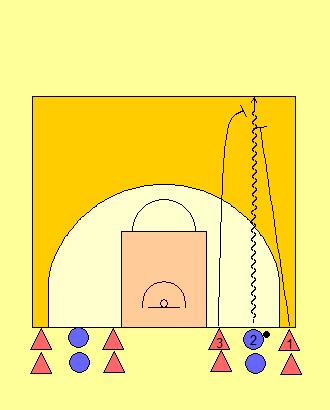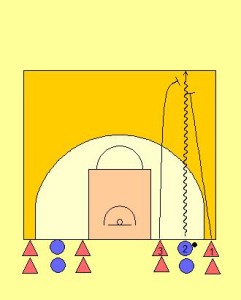1 v 2 HC Trapping Drill

The 1 v 2 HC Trapping Drill is a simple activity for defensive players who are learning how to form a trap. Providing quick fire opportunities for players to practice advanced skills like trapping can be very difficult, as many drills seem to be played out in the full court. This is not ideal for teaching as the repetitions are slowed and it is hard to provide a decent amount of repetitions for any one player. The 1 v 2 HC Trapping Drill overcomes these issues and allows a high rate of practice for a team.
One of the great aspects about the 1 v 2 HC Trapping Drill is that it starts in the half court and allows players to practice the tactic of trapping in short sharp bursts. Players should be pushed within the drill to ideally be working at a game pace once they start to understand the positioning and what they are responsible for as defenders. Coaches should look to take the breaks within player’s repetitions to provide feedback and limit stoppages to the drill.
The 1 v 2 HC Trapping Drill starts with three lines of players on each side of the court. One side performs the activity while the other waits. This is to avoid any collisions between the two groups as they progress towards the basket.

The inside lane (lane closest to the basket) is for one defender (Three).
The middle lane is for the offensive player (Two) who starts with the ball.
The outside lane is the second defender (One).
The drill starts with Two (2) dribbling as fast as possible to halfway. Two (2) must place at least one foot on the halfway line before turning and trying to attack the basket for a shot.
When the offensive player has taken two dribbles off the baseline, then the two defenders (One and Three) can enter the drill and start to chase down the ball.
The responsibilities for the defenders are as follows:
- Three (3) is responsible for filling the role of the denying the middle of the floor to the offensive player (Two).
- One (1) is responsible for denying the sideline to Two (2).
- Both defenders are responsible for not allowing the offensive player to split them and dribble between them.
Once one side of the floor has completed a repetition. The other side of the floor starts.
Point of Note
The 1 v 2 HC Trapping Drill not only allows defenders to practice the action of trapping between two defenders. But highlights an often overlooked advantage by players just starting out in the exercise is that the halfway and sidelines are effectively additional defenders. Player’s attention needs to be drawn to the advantage of pinning the offensive players against this area and if possible working the ball handler as far as possible into the corner of the half court so the trap becomes more effective.
Variation
To start with, it is suggested that the offensive player be allowed to attack the basket if they can break the trap. This should be played out as a live 1 v 2 situation with both defenders needing to stop the shot should a breakdown in the trap happen. In these situations within games, if a trap is broken, the end result is often a defensive foul. Do not allow players to just simply foul. Drill what each defender should be doing with regards to the where the ball is and their positioning is initially when the trap is broken.
If the 1 v 2 HC Trapping Drill seems a little slow for your liking, simply take away the goal of the offense scoring and replace it with the offensive player just needing to get two feet inside the three-point line. This will speed up the repetitions and allow for a greater degree of learning to take place in regards to performing the trapping action.
Another option to vary the drill is to change which lines are offense and defence on the baseline. This will provide a different perspective for all players involved.
The 1 v 2 HC Trapping Drill is a good activity for players to define their understanding about how to trap. Because the offensive player starts facing away initially in the drill the defence has a little more time in which to perform the activity and gain the correct positioning. This will make a difference to those players (young and old) who just need to understand or tweak their trapping technique.
Related articles





